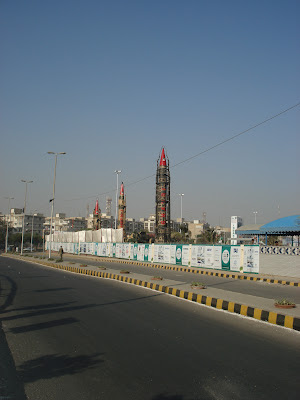On
Wednesday night, collective chills should have been rolling down the spines of
every person on the planet. At 2 a.m. local time, members of the Pakistani
Taliban attacked the Kamra military base outside of Islamabad wielding
rocket-propelled grenades and automatic weapons. In the hours that
followed, one of Pakistan’s rumored nuclear facilities came under siege by the
militants, who employed tactics that eerily resembled those cited by Pakistani
security expert Shaun Gregory when describing how extremists could effectively
take over a Pakistani nuclear compound:
“If
they were after something specific, or were truly seeking entry, you’d think
they might use a different tactic, one that’s been employed elsewhere – such as
a bomb followed by a small-arms assault.[1]”
Fortunately
for the world, the attackers were killed and the facilities ostensibly remained
secure. Not so luckily, this is far from the first assault on a rumored nuclear
compound in Pakistan, and certainly will not be the last. With an uncontrolled
insurgency brewing within its borders and without, Pakistan’s military must
contend with extremist threats from Al Qaeda, the Taliban, and other fringe groups
who would like nothing more than to possess the most deadly and profoundly
frightening weaponry on earth.
These
attacks have repeatedly called into question the actual level of security
surrounding Pakistan’s nuclear materials and delivery systems. Although the
locations, size, and deployment plans of the arsenal are held under the utmost
secrecy, experts have speculated for years that Pakistan probably has about
90-110 nuclear weapons and is seeking to build more. These weapons are
supposedly kept separate from their delivery mechanisms and are largely a
deterrent to India’s own stockpile of nukes.
Pakistan
started its secret nuclear weapons program in 1972 just one month after the
loss of Bangladesh (formally Eastern Pakistan) in a war with India. Since then,
there have been several close calls with nuclear warfare in a Cold War-esque
arms race between the two countries: the 1999 Kargil crisis, the 2002 conflict
at the Line of Control, and at every release of new information regarding the
A.Q. Khan Network. Pakistan’s stated policy is that it would never launch a
first-strike against a non-nuclear country that threatens its security; against
a nuclear-armed India, however, the stance is quite clear: nothing is off the
table.
Pakistan shows off some of its missiles at a defense exhibition in Karachi
Besides being the country most likely to set off a nuclear conflict by its own volition, Pakistan is also the most likely country to lose control of its weapons to extremists and other violent groups. In a recent Atlantic Monthly cover story, Jeffry Goldberg described the international community’s anxiety over Pakistan’s nuclear arsenal as being due to the fact that “Pakistan is an unstable and violent country located at the epicenter of global jihadism, and it has been the foremost supplier of nuclear technology to such rogue states as Iran and North Korea. It is perfectly sensible to believe that Pakistan might not be the safest place on Earth to warehouse 100 or more nuclear weapons.”
The
extent of that lack of safety is called to the forefront time and time again
with extremist attacks on Pakistan’s military bases rumored to house the
weapons. Kamra has been the subject of two previous attacks, one in 2009 by a
suicide bomber on a bike outside of the base that killed seven people, and one
in 2007 when 5 children were injured when a suicide bomber attacked an air
force bus bringing them to a school near the base. In Karachi, a 2011 attack
saw assailants scaling the walls, killing 10 people and destroying two
U.S.-supplied maritime surveillance aircraft. An October 2009 attack on a
military headquarters in Rawalpindi led to a 22-hour standoff and 23 dead. The
list of examples goes on and on through the years. Despite the number of lives
lost, these attacks were small in comparison from what would result should
terrorist or extremist groups actually succeed in attaining the weapons housed
in these facilities.
Pakistan’s
record with safeguarding its nuclear technology is so full of holes it begs the
question of why the U.S. seems so concerned with countries such as Iran that
have yet to develop nuclear capability, while it seemingly ignores the fact
that weapons already possessed by Pakistan stand to fall into dangerous hands
at any minute. One of the creators of Pakistan’s initial nuclear program, A.Q.
Khan, sold for profit nuclear secrets to such countries as North Korea, Libya,
and Iran. While his network was dismantled, former Pakistani nuclear scientists
abound that are more than willing to sell nuclear information to the highest
bidder. Hell, you can Google Pakistani nuclear sites and get a pretty good idea
of just where they are located, all thanks to satellite technology.
Suspected nuclear sites in Pakistan. Source: The Atlantic Monthly.
So
why are we allowing this unstable, fair weather friend of the U.S. to maintain
its shaky control over nuclear weapons? For one, America depends on Pakistani
cooperation to continue to wage war in Afghanistan against Al Qaeda and the
Taliban. Secondly, the alternative is to make nice with Iran and other
less-than-appetizing countries to fill in the gaps when Pakistan throws its
hissy fit over losing its nukes and quits helping us out in the War on Terror.
Given
the choice of taking the deadliest weapons known to earth out of the hands of
what can often be described as America’s worst ally and a good chance of
nuclear war, however, I’d prefer the former. Sorry, Pakistan, like Colin
Wolfgang, I just don’t trust you anymore.
[1] http://thelede.blogs.nytimes.com/2009/08/11/have-pakistani-nuclear-facilities-already-been-attacked/



I especially like your highlighting of the discrepancy between our hair-tearing over Iran's nuclear program, which is still in progress, and Pakistan's existing stockpile, which is real and vulnerable.
ReplyDelete